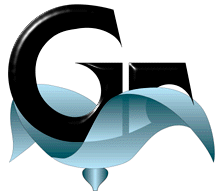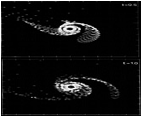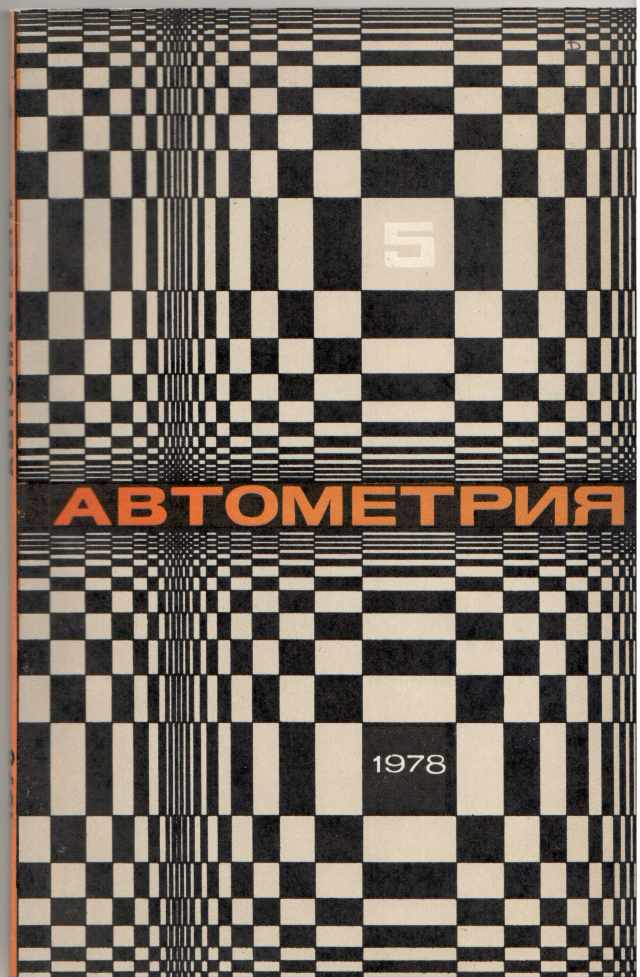The history of machine graphics in the Soviet Union began almost simultaneously with its birth in the United States. This collection includes some of the facts of the story. We hope that the selection will be expanded and updated.
We will be very grateful for any historical facts about machine graphics and vision in Russia and with great pleasure we inscribe them in the chronicle. Please send the information to our address contact@graphicon.ru
1964
The first computer visualization
At the Institute of Applied Mathematics, Moscow, Bayakovsky Y.M. and Sushkevich T.A. demonstrated the first practical experience of machine graphics when printed on haraktron sequence of frames that make up a short film with the visualization of plasma flow around a cylinder.
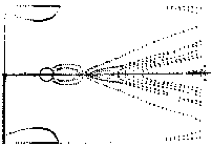
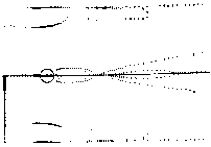
1968
The first national bitmap display
The Computing Center of the USSR, on the BESM-6 is the first national raster display, the video memory on a magnetic drum weighing 400 kg.
The first thesis on machine graphics at Moscow University
Folker Heimer. Translator and interpreter for the programming language L^6.
The realization of the language L^6 proposed by Kenneth Knowlton to solve some problems of the animation.
The world's first cartoon, drawn by computer.
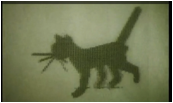
Made of a sequence print on paper tape using BESM-4. This cartoon in his time was a big breakthrough in computer modeling, because the picture is not just painted, and we obtain the solution of equations defining the moving of the cat.
1970
Released the first review of machine graphics, then presented as a report at the Second All-Union Conference on Programming (WCP-2).
Shtarkman V.S., Bayakovsky Y.M. Machine graphics. Preprint IPM USSR, 1970.
Apparently, this is the first publication in Russian, in which the phrase machine graphics appear.
1971
The first films using computer
In the Keldysh Institute of Applied Mathematics for the car SDS-910 has been developed a set of routines that allows you to shoot movies, set the camera for still image capture, output to a display screen. With the help of this system was made visualization of the behavior of a walking robot and simulation of gravitational interaction of galaxies.
 |
|
1972
The first library of graphics programs Grafor (Графор)
The first version of the library allows you to output to a plotter, and then on the screen, the graphics primitives (line segment, arc, alphanumeric characters), and on the basis of their plot functions. Later library enriched programs affine transformations, shading, shielding approximation and spline interpolation, two-dimensional imaging software features (surface and contour maps) and geometric constructions. Grafor has been implemented on most existing at that time in the Soviet Union computers and operating systems with the withdrawal of almost all the plotters and graphic displays. Stage creation a classic graphics library Fortran was completed in 1985 edition of the book Grafor. Graphical extension of Fortran (authors - Yu.M.Bayakovsky, T.N.Mihaylova, V.A.Galaktionov, circulation - 40 thousand copies).

Defended the first dissertations in machine graphics in the Soviet Union
We list here first few dissertations:
-
Alexander A. Karlov
Questions of the software screen with a light pencil and its use in the problems of experimental physics
Dubna, 1972 -
Victor M. Greene
The software to work with three-dimensional objects on the graphic display terminal
Novosibirsk, 1973 -
Yuri M. Bayakovsky
Analysis of methods of developing machine graphics software
Moscow, 1974 -
Evgeny M. Zlotnik
Research and development of technical means and methods of operative graphical system design
Minsk, 1974 -
Simon T. Lysyi
G1 - Geometry software system
Chisinau, 1976 -
Sergey Y. Piguzov
Research and development of graphical interaction with computers in geophysics seismic data processing
Moscow, 1976
1976
The book U.Nyumena, R.Sprulla Fundamentals of Interactive Machine Graphics (edited V.A.Lvov) is published in Russian.
1977
The first meeting of CG researchers
The first meeting of CG researchers was held in Novosibirsk in 1977. The event was announced as the "regional conference", but gathered sufficiently representative community turned Union. Part of the report was selected for publication in the Journal of Avtometriya, which is what happened in 1978.
1979
First All-Union conference on machine graphics held in Novosibirsk in September.
List of the following conferences:
-
All-Union conference on problems of machine graphics
Novosibirsk, 1981 г. -
All-Union conference on problems of machine graphics
and digital imaging
Vladivostok, 24-26 September 1985 г. -
IV All-Union conference on problems of machine graphics
Protvino, 9-11 September 1987 г. -
V All-Union conference on problems of machine graphics "Machine graphics 89"
Novosibirsk, 31 October-2 November 1989 г.
The first halftone color raster display Gamma-1 (Гамма-1)
The first display station “Gamma is suitable for active use in film and television, created in the Institute of Applied Physics in Novosibirsk Akademgorodok by the Vladimir Sizykh, Peter Veltmander, Alexei Buchnev, Vladimir Minaev etc. Resolution of the first station was 256 × 256 × 6 bits, and then continuously increased. Display station Gamma 7.1 provides a resolution of 1024 * 768 for the progressive scan monitor 50Hz and had 1MB video memory. In the second half of the 1980s “Gamma”, mass-produced, delivered and successfully exploited the country's public telecentres.
1981
Graphics package Atom appears.
Development of the package was initiated Bayakovsky Y.M. Package was base on Core System (Kaminsky, Klimenko, Cochin).
1983
The first course on machine graphics.
Bayakovsky Y.M. started reading the annual course onmachine graphics to students of the Faculty of Computational Mathematics and Cybernetics, Moscow State University. Since 1990, the course is taught as a compulsory for students of the second year of study.
1985
The first report adopted by the Eurographics 1985
"Break the window into the graphics Europe" - the first report of the USSR adopted the conference Eurographics 1985. However, since the Restructuring has not yet begun, the rapporteurs were not allowed to leave the USSR, and the first time a Soviet delegation visited the conference in 1988 alone.
1986
Atom-85 package comes at CERN.
Graphic Package Atom-85 released at CERN, which is actively used (along with Graforom) tasks for illustrative graphics (Klimenko, Cochin, Samarin).
1990
The first Russian computer graphics software company "Drive" is organized. SciVis conference
In 1989, Alexander Pekar, Sergei Timofeev, Vladimir Sokolov organized a studio of computer graphics on base of the “Movie” organization(ВПТО "Видеофильм") which a year later became the first independent computer graphics company, moved from the wing of the Videos” in the Central Pavilion Exhibition Center.
Also in 1990, the first conference on SciVis, where Galaktionov was invited Greg Nielson (yet unannounced). The following year, in 1991 at the 1st Seminar Series SciVis-Dagstuhl, we presented a report on the visualization in high-energy physics.
1991
In February, Moscow hosted the first international conference on computer graphics and vision GraphiCon'91
The first conference GraphiCon was organized USSR Academy of Sciences, represented by the Keldysh Institute of Applied Mathematics, the Union of Architects of the USSR and some other organizations, with the assistance and support of the international association ACM Siggraph (USA). Among the American guests were executives of world size, have already entered into the history of computer graphics, such as Ed Ketmull, president of "Pixar", who created Star Wars with George Lucas. The other reports (translated and published by the conference organizers in Russian) also presented John Lassiter from "Pixar", who the day before (in 1989) was the first ever Oscar for computer animation (the film "Tin Toy", shown at the conference), and the legendary Jim Clark, the founder of the company "Silicon Graphics" for many years the former trendsetter in the field of professional graphics workstations.
 |
<< The MovieShadow was created by the working group (Boris Mazurok, Sergei Michaev, Alexander Cherepanov) under my direction at a specialized three-dimensional imaging system Albatross, which is the main purpose of the training of astronauts and pilots. Albatross system was developed in the Institute of Automation and Electrometry, Siberian department of the USSR Academy of Sciences.>> Boris Dolgovesov |
|
|
<<... Moving on to more conventional 3D animation there was "Shadow" from the USSR (commended). Although done on a pretty unsophisticated system, this showed what a bit of humour and good observation of human movement is capable of. >> A.J.Mitchell, The birth of a new art. |
CQuoted book DER PRIX ARS ELECTRONICA. International Compendium of the Computer Arts. Hannes Leopoldseder. - Linz - VERITAS-Verlag, 1991.
1993
The first festival of computer graphics and animation ANIGRAPH'93 was held.
In 1992, Vladimir Loshkarev, head of the firm "Joy Company", engaged promotion of the Russian market of graphics software packages and equipment, organized the first scientific conference on computer graphics. The idea of the festival combines both the technical side and commerce and pure art came at that time. Anigraph festival was organized with the participation of the Institute of Cinematography, co-chairman of the organizing committee was Sergei Lazaruk (vice-rector for scientific and creative work of the Institute of Cinematography). The exhibition presents all the major manufacturers of graphics workstations. In the creative competition featured more than 50 works.
Unfortunately, the festival did not celebrate the tenth anniversary, and was closed as a commercially untenable.
The First Russian cartoon with a three-dimensional computer graphics.
Novosibirsk studio "Albatross" has established the first domestic cartoon three-dimensional computer graphics "Misha - maiden voyage", which in 1993 was presented at the Russian TV.
1994
The first computer graphics in the domestic film.
In the film "Burnt by the Sun" episode of the fireball was prepared by "Render Club".
1996
The first attempts to collect and organize historical facts.
Timour Paltashev. Russia: Computer Graphics -- Between the Past and the Future. Computer Graphics, vol.30, No. 2, May 1996. Special issue: Computer Graphics Around the World.
Yuri Bayakovsky. Russia: Computer Graphics Education Takes Off in the 1990's. Computer Graphics, Vol. 30, No. 3, August 1996. Special issue: Computer Graphics Education -- Worldwide Effort
2000 год
Special edition of magazine Computer&Graphics Vol.24 "Computer Graphics in Russia."
2001 год
First appearance of virtual realilty in Russia.
The first conference in the series VEonPC in Protvino with a demonstration of Russia's first virtual reality installation. The demonstration was created by a group of Stanislav Klimenko in cooperation with Martin Goebel (IMC S.Avgustin).
2003
The first conference of computer games developers GDC-2003. (КРИ-2003)
21 and March 22, 2003 in the Moscow State University hosted the first international conference of game developers (CGD) in Russia, organized DEV.DTF.RU - leading specialized resources in RuNet for game developers and publishers. GDC 2003 for the first time in the history of Russia's gaming industry has collected almost all industry professionals to exchange experiences and discuss a wide variety of problems. At GDC 2003 was attended by about 40 companies from Russia, as well as near and far abroad, acting as in the development and publication of the game software. Total number of visitors ranged from 1,000 to 1,500 people.
2006
The first practice conference on computer graphics and animation CG Event-2006.
Inspired by SIGGRAPH conference, S.Circin (author of book "Understanding Maya") and A. Kostin (creator of cgtalk.ru website) organized the first practice conference on computer graphics, CG Event, which became the ideological heir of the festival Anigraph. In the first CG Event was attended by over 500 people, and subsequently the number of participants grew.
References:
- Encyclopedia of Russian cinema http://www.russiancinema.ru/template.php?dept_id=3&e_dept_id=5&e_chr_id=416&e_chrdept_id=2&chr_year=1993
- http://www.kriconf.ru/2003/
- "Budget 3D». Computerra. http://www.computerra.ru/video/287273/
- The first steps of digital television in the USSRhttp://broadcasting.ru/articles2/Mashina/pervie-shagi-cifrovogo-televideniya-v-sssr-1
